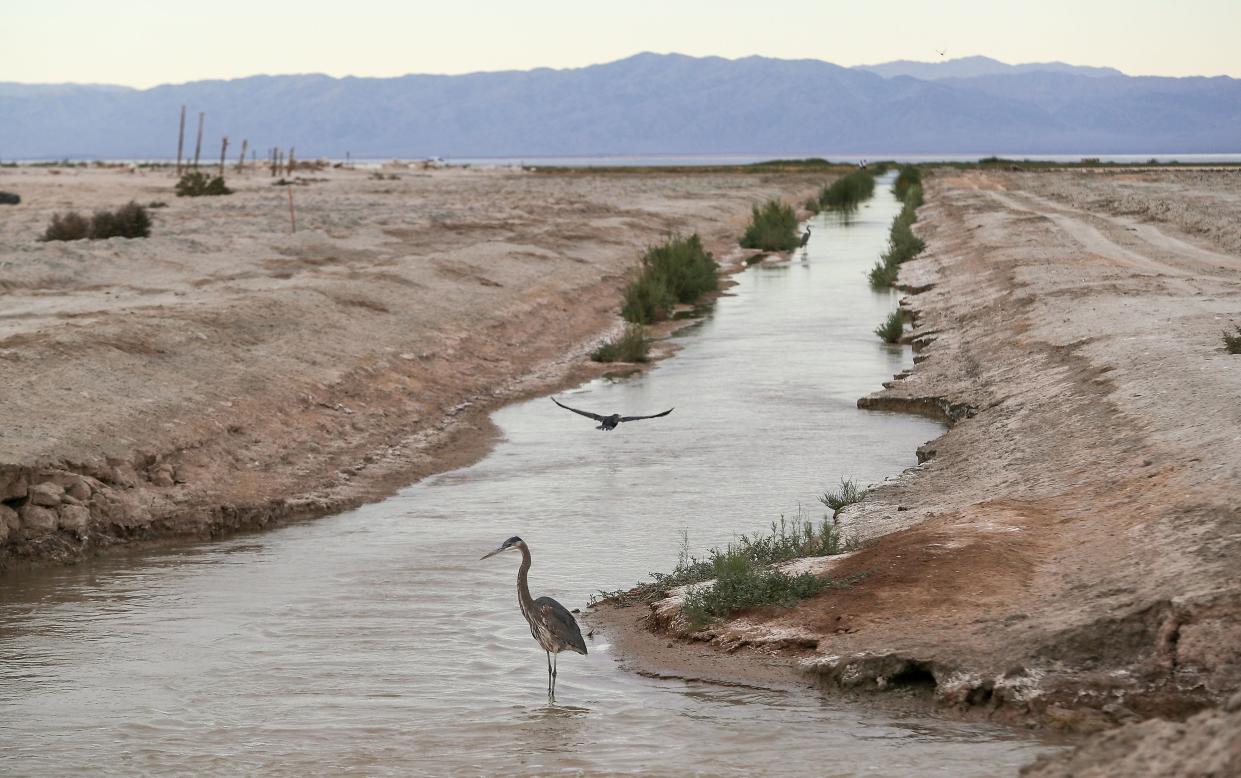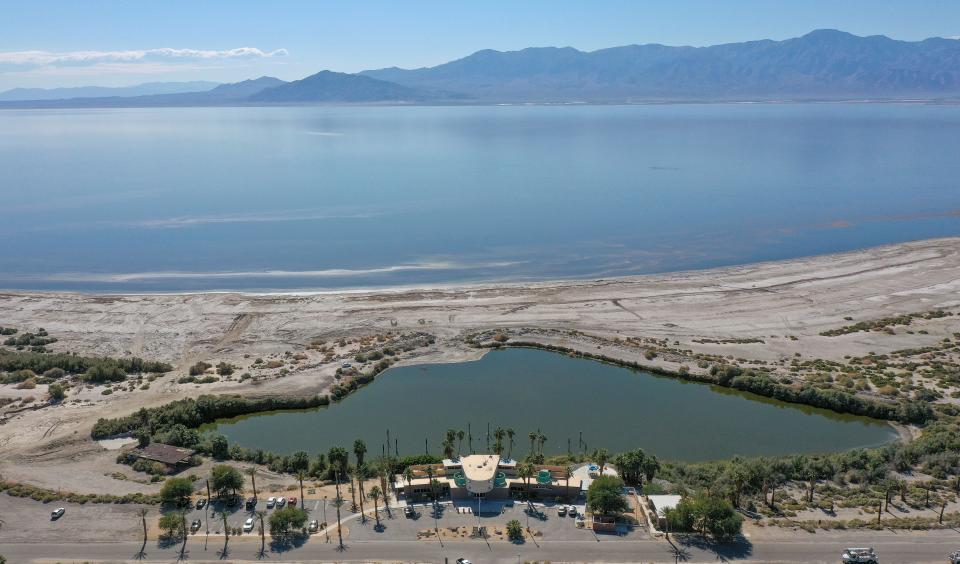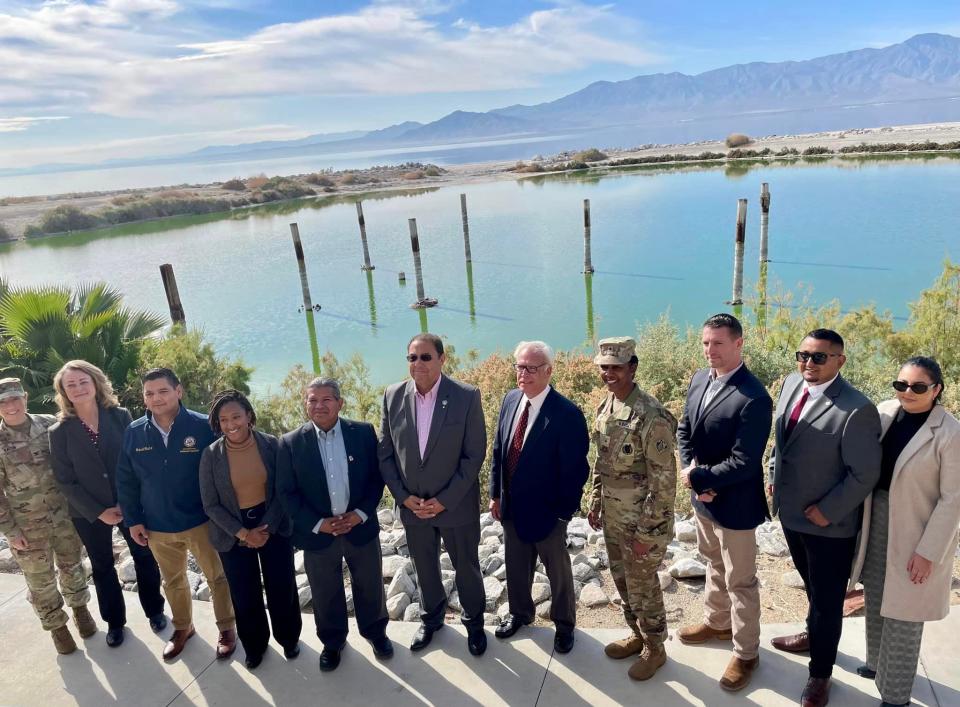As the first major project at the Salton Sea nears completion, what’s next?

After years of studies, public meetings and deliberation over the future of the receding Salton Sea, the first visible signs of major projects at the sea are starting to appear.
Local and state officials are hoping to build on the momentum generated by the near-completion of the largest project at the sea to date: The 4,100-acre Species Conservation Habitat Project along the sea’s southern edge should be finished by the end of the year; a pilot project along the northern edge is officially in the works; and the U.S. Army Corps of Engineers is in the early stages of a feasibility study focused on potential long-term solutions at the Salton Sea.
But the state is still playing catch-up in its efforts to reach a target of 30,000 acres of projects that suppress dust from the exposed lakebed and create habitat for fish and birds by 2028. The state is also facing concerns from some community members who wonder if and when noticeable progress will be made on air quality and other issues at the Salton Sea.
“As a resident, since the Salton Sea Management Program started you’re always hearing about the 10-year plan, but it took so many years to just get it off the ground, that sometimes you lose trust a little bit about the progress. And I think it’s really encouraging to see (the Species Conservation Habitat Project) almost finished,” said Daniela Flores, an organizer with the Imperial Valley Equity and Justice Coalition.
“There’s been great concern that projects were moving too slowly, and that’s still a concern. But certainly, I think this past year we saw that there is some progress being made,” Flores continued.
Progress at the sea can sometimes be hard to track, especially since most headway over the past several years has taken the shape of annual reports, dense environmental studies, and public meetings, rather than visible progress on the ground. Assemblymember Eduardo Garcia recently acknowledged this at an event marking the start of surveying work for a project along the sea’s northern edge:
“(The community) has participated in conversations about the Salton Sea, and for many of them, the motivation of not seeing an actual project within eye view has been very frustrating,” Garcia said at the October event, noting that the Species Conservation Habitat Project is along the sea’s southern edge. “That project is out of sight, and when something is out of sight — for many people — it’s out of sight, out of mind.”
The Salton Sea, which is roughly twice as salty as the ocean, covers about 325 square miles, almost twice the surface area of Lake Tahoe, but it is rapidly shrinking. Since 2003, the sea's elevation has dropped by about 10 feet and its surface area has shrunk by about 38 square miles, according to the Water Education Foundation. The sea’s receding shoreline has resulted in exposed lakebed that has left residents breathing in toxic dust for years while important bird and fish habitat also shrinks.
The Salton Sea relies on irrigation runoff from the Coachella and Imperial valleys, but the Quantification Settlement Agreement that took effect in 2003 saw hundreds of thousands of acre-feet of water per year transferred from the Imperial Irrigation District to the San Diego County Water Authority and other parties. The agreement decreased the amount of agricultural runoff into the Salton Sea, and with further reductions expected due to mandated cuts to Colorado River water use, the crisis at the Salton Sea has taken on additional urgency over the past few years.
The state first pledged to fix the Salton Sea in September 2003, when Gov. Gray Davis signed the Salton Sea Restoration Act. California released its 10-year Salton Sea plan in March 2017. Later that year, the State Water Resources Control Board passed an order that requires the board to hold annual meetings each year during that 10-year plan to hear a report on the status of the Salton Sea restoration from the California Natural Resources Agency. The order also sets specific restoration milestones for each year, and the California Natural Resources Agency must produce an annual report detailing its progress toward those milestones.
Salton Sea: Five years into California's 10-year plan
The Salton Sea Management Program’s 10-year plan sets a target of constructing 30,000 acres of projects by 2028, with specific acreage targets each year set by the 2017 order from the State Water Resources Control Board.
Now about halfway to the 2028 deadline, the state is supposed to have 11,500 total completed acres of habitat and dust-suppression projects by the end of 2023. These projects fall into two categories: aquatic habitat projects like wetlands and dust suppression projects like planted vegetation.
Currently, the Salton Sea Management Program has interim dust control measures in place on 5,356 acres of projects that are currently under construction. A total of 368 acres are considered completed, which is defined as "flooded for aquatic habitat and planted and irrigated for vegetation enhancement dust suppression projects," according to Tony Andersen, Deputy Secretary for Communications at the California Natural Resources Agency.

“We are making progress demonstrably toward our acreage targets within the Salton Sea Management Program,” California Natural Resources Secretary Wade Crowfoot told the State Water Resources Control Board during the board’s annual workshop focused on progress on Phase 1 of the Salton Sea Management Program in May. “I need to be clear though, we continue to come from behind in terms of meeting our acreage targets and we have to continue to make up more ground to catch up to the schedule in terms of the amount of acres that would be mitigated for dust emissions, which of course are so critical to protect public health as well as the acreage required to restore habitat for fish and wildlife that use the Salton Sea.”
At that same meeting, some public commenters criticized the state’s lagging behind on annual acreage targets and expressed doubt over the state’s ability to catch up.
“It’s really hard not to repeat the same concerns over and over again, at each of these meetings. I would like to give credit to the state agencies, elected officials, and a host of NGOs and others that are trying, but it looks to me like we are falling further behind on the SSMP timeline,” Tim Floyd, a Coachella Valley resident, said at that May meeting.
E. Joaquin Esquivel, chair of the State Water Resources Control Board, responded by “acknowledging” that “hopefully folks can feel the progress that’s there, but also the urgency we all feel because we’re so behind on the work that’s necessary.”
Another public commenter, Tom Sephton, noted that in order to meet the 30,000-acre target, “you’re going to have to get three times as much built (from 2024 to 2028) as was accomplished in the first five years.”
Getting access to land around the Salton Sea has long been one barrier for projects. Of the roughly 235,000 acres of land around and under the sea, a total of about 210,000 acres are owned by the four biggest landowners: Imperial Irrigation District, U.S. Bureau of Reclamation, U.S. Bureau of Land Management, and the Torres Martinez Desert Cahuilla Indians. The state only owns about 3,900 acres.
This different land ownership has required the state to enter land access agreements to start projects at the Salton Sea. A more streamlined process was created in December 2022, when the Department of the Interior, IID, and Coachella Valley Water District agreed to establish programmatic land access agreements for state agencies to implement Salton Sea projects.
As of March 2023, the state had gained land access to 15,800 acres around the Salton Sea, up from 5,800 the year before.
A big win: Species Conservation Habitat project
Officials are also pointing to the Species Conservation Habitat project as one major sign of progress along the Salton Sea.
“We are fully focused on scaling up, on bringing the projects that we have under construction right now to completion, and then duplicating that effort and scaling up so we’re reaching those acreage targets,” Samantha Arthur, the Assistant Secretary for Salton Sea Policy at the California Natural Resources Agency, told The Desert Sun this week. Arthur started in the position in April.
Billed in the state’s annual Salton Sea report as the “first large-scale project” under the Salton Sea Management Program, the project will restore about 4,100 acres of shallow water habitat lost to the sea’s receding shoreline and increasing salinity. A large network of ponds and wetlands will provide fish and bird habitat and suppress dust emissions from the receding shoreline along the sea’s southern edge.
Construction is now complete on the project, which involved building berms, islands and a mile-long causeway stretching into the sea that connects to a pump station with a dredge channel extending another four miles into the sea. The pump station will provide water for habitat ponds, along with a diversion structure that will divert water from the New River.
The long dredge channel and causeway are expected to allow officials to maintain the project for at least the next 35 years as the shoreline recedes.
According to Arthur, the next steps will involve flooding about 130 acres of the project to fill it with water by the end of this year. The rest of the project likely won't be flooded until after an expansion project that would add roughly another 3,000 to 5,000 acres to the Species Conservation Habitat project. Once that expansion is constructed, water would then be added to both the rest of the initial project and the expansion.
Next on deck: North Lake Pilot Demonstration Project
On the northern end of the sea, preliminary survey work began in October on the North Lake Pilot Demonstration Project, a long-envisioned effort led by Riverside County that will create an approximately 156-acre lake with both deep and shallow water habitat, as well as potential recreation opportunities. The pilot project could eventually be combined with the larger 1,600-acre North Lake project, which is in the permitting and design phase this year. An additional wetlands project helmed by Audubon near Bombay Beach is slated for over 800 acres.

Other acreage progress at the sea so far has mostly been in the form of vegetation projects that aim to reduce dust emissions by planting native plants and placing temporary bales of grass on the exposed lakebed while the plants grow. This has included approximately 1,200 acres of vegetation enhancement at Tule Wash near Salton City, 91 acres near Bombay Beach, and another roughly 400 acre project near Salton City.
The state's goal is to start construction on the North Lake Demonstration Pilot Project, the North Lake Project, the Species Conservation Habitat Expansion Project, and a few other smaller vegetation projects by the end of 2024, and to continue implementing those projects through 2025 to meet the target of 17,600 cumulative acres that year.
But beyond that, a comprehensive schedule for projects in 2026 through 2028 is still in the works. This year's annual report on the Salton Sea notes that "a comprehensive project pipeline and schedule" for 2026, 2027 and 2028 will be developed after the completion of an environmental assessment document by the U.S. Army Corps of Engineers. Information about the 2026-2028 projects is expected in next year's annual report, according to Andersen.
"They are way, way, way behind the milestones that the State Water Board memorialized, which were based on estimates that the Salton Sea Management Program team came up with," said Michael Cohen, a senior researcher with the Pacific Institute who has spent decades focused on the Colorado River basin and the Salton Sea. Cohen says those initial estimates may have been "a little optimistic."
"They've been running against that hurdle for a while now, and even when they get the SCH habitat project up and running, they're still not caught up, but with the expansion project they'll be closer . . . The challenge is after that expansion project, it's not clear what else is really in the pipeline," Cohen said, adding that it may be challenging to obtain water sources for the North Lake projects along the sea's northern shore.
Looking beyond 2028: Addressing sea shrinkage, salinity
While these 10-year plan projects are focused on mitigating the impacts of a receding Salton Sea, additional and larger-scale action will be needed to actually address the underlying issue of a sea that is shrinking in size and increasing in salinity each year due to reduced inflows.
But a few more years of studies stand in between now and when a long-term solution is selected.
The idea of importing water from Mexico’s Sea of Cortez or the Pacific Ocean off California’s coast has been floated for years as one possible solution to the Salton Sea’s declining water levels. After first putting out a call for water importation proposals in 2017, the state established an independent review panel in October 2021 to evaluate a total of 18 water importation proposals submitted between 2018 and 2021. The seven-member independent Salton Sea panel was coordinated by UC Santa Cruz and chaired by Rominder Suri, a Temple University civil and environmental engineering professor who specializes in water, environment and technology.
In the summer of 2022, the panel first narrowed down the 18 concepts to move three forward for further study, all of which involved importing water from the Sea of Cortez. But in a final report issued in September 2022, the panel ultimately did not recommend importing water from the Sea of Cortez to address long-term problems at the Salton Sea, citing high costs and potential environmental damage, and instead recommended a combination of desalination and water from the Imperial Irrigation District.
The panel recommended building a large desalination plant near the Salton Sea that would treat 200,000 acre-feet of water a year. After desalination, 100,000 acre-feet of pure water would be returned to the sea each year. To replace that lost 100,000 acre-feet, the panel recommended compensating farmers to let their land go fallow, with the saved water flowing into the Salton Sea.
This recommendation was criticized by proponents of water importation, which has included private-sector engineers and local groups like EcoMedia Compass, with some public commenters at the independent review panel meeting questioning whether such a fallowing program would be feasible given ongoing drought conditions and cuts to Colorado River water use.
New direction? 'Smaller sea and larger playa'
One of the key conclusions from the independent panel was that "it is not necessary to refill the Salton Sea to its mid/late 20th-century volume. A lower-volume sea can also achieve today’s environmental, air quality, and economic goals for the region. This conclusion led the panel to reframe the role of imported water." The panel’s report envisioned a future Salton Sea with “a smaller sea and a larger playa.”
However, ultimately the independent review panel was only making recommendations, not determining which path the state will take for long-term restoration at the sea. The state was required to complete a draft long-range plan for action at the Salton Sea by the end of 2022, and considered the panel’s recommendations as “one point of information” in developing that report.
That draft long-range plan didn’t identify one preferred solution, but instead recommended a wide range of concepts for further evaluation, including building and filling a narrow “perimeter lake” around the edge of the exposed lakeshore, splitting the lake in two, building desalination plants, or importing water from the Sea of Cortez, among other proposals. A final long-range plan is expected around the end of this year.
The next step is a feasibility study by the U.S. Army Corps of Engineers focused on evaluating which of more than a dozen possible large-scale engineered solutions are feasible.

"The study will explore a range of options, " Arthur said, "and the latest technologies including concepts that rely on in-basin water sources, as well as water import options.”
So water importation is still on the table, but the timeline is unclear. Arthur said the three-year study likely will be extended to five years.
“That’s the work that will identify a plan for long-term restoration, and I also want to emphasize the importance of us really focusing on carrying out the projects under our 10-year plan, because that’s what needs to happen now as well, on two parallel tracks,” she said.
Meanwhile, Flores says she hopes to see action at the Salton Sea go beyond acreage targets and restoration plans, and toward a more holistic approach that also focuses on health care and infrastructure in the region.
"While efforts to suppress the dust are in place, children are still dying from not being able to get to the hospital in time when they have an asthma attack," said Flores. "I think we've heard loud and clear from residents that restoration efforts should be discussed in a more holistic approach that considers infrastructure for residents to mitigate the negative health outcomes that result from living around the Salton Sea and being exposed to the particulate matter."
This article originally appeared on Palm Springs Desert Sun: Salton Sea: What's next as major state project nears completion

